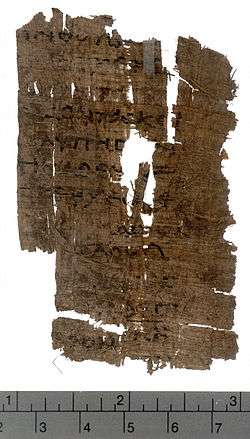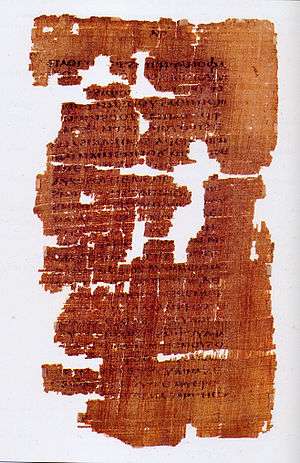Gospel of Marcion
The Gospel of Marcion, called by its adherents the Gospel of the Lord, was a text used by the mid-2nd-century Christian teacher Marcion of Sinope to the exclusion of the other gospels. The majority of scholars agree the gospel was an edited version of the Gospel of Luke.

Although no manuscript of Marcion's gospel survives, scholars such as Adolf von Harnack and Dieter T. Roth[2] have been able to largely reconstruct the text from quotations in the anti-Marcionite treatises of orthodox Christian apologists such as Irenaeus, Tertullian, and Epiphanius.
Contents
Like the Gospel of Mark, Marcion's gospel lacked any nativity story. Luke's account of the baptism of Jesus was also absent. The gospel began, roughly, as follows:
In the fifteenth year of Tiberius Caesar, Pontius Pilate being governor of Judea, Jesus descended into Capernaum, a city in Galilee, and was teaching on the Sabbath days.[3][4] (cf. Luke 3:1a, 4:31)
Other Lukan passages that did not appear in Marcion's gospel include the parables of the Good Samaritan and the Prodigal Son.[5]:170
While Marcion preached that the God who had sent Jesus Christ was an entirely new, alien god, distinct from the vengeful God of Israel who had created the world,[6]:2 this radical view was not explicitly taught in Marcion's gospel.[5]:169 The Gospel of Marcion is, however, much more amenable to a Marcionite interpretation than the canonical Gospel of Luke, because it lacks many of the passages in Luke that explicitly link Jesus with Judaism, such as the parallel birth narratives of John the Baptist and Jesus in Luke 1-2.
Relationship to the Gospel of Luke
Scholars have entertained three possible hypotheses concerning the relationship between Marcion's gospel and the Gospel of Luke. The traditional view, espoused by early Church Fathers in their polemics against Marcion, is that the Gospel of Marcion was produced by removing passages from Luke that contradicted Marcion's theological views. The two other possibilities are that Luke was created by adding anti-Marcionite passages to Marcion's gospel, or that both Luke and Marcion's gospel are edited versions of some lost prior gospel. Those who espouse this last view usually maintain that the Gospel of Marcion is closer to the original than canonical Luke.
As a revision of Luke
Church Fathers wrote, and the majority of modern scholars agree,[7][8] that Marcion edited Luke to fit his own theology, Marcionism. The late 2nd-century writer Tertullian stated that Marcion, "expunged [from the Gospel of Luke] all the things that oppose his view... but retained those things that accord with his opinion".[9]
According to this view, Marcion eliminated the first two chapters of Luke concerning the nativity, and began his gospel at Capernaum making modifications to the remainder suitable to Marcionism. The differences in the texts below highlight the Marcionite view that Jesus did not follow the Prophets and that the earth is evil.
| Luke | Marcion |
|---|---|
| O foolish and slow of heart to believe in all that the prophets have spoken (24:25) | O foolish and hard of heart to believe in all that I have told you |
| They began to accuse him, saying, ‘We found this man perverting our nation . . .’ (23:2) | They began to accuse him, saying, ‘We found this man perverting our nation . . . and destroying the law and the prophets.' |
| I thank Thee, Father, Lord of heaven and earth... (10:21) | I thank Thee, Heavenly Father... |
Late 19th- and early 20th-century theologian Adolf von Harnack, in agreement with the traditional account of Marcion as revisionist, theorized that Marcion believed there could be only one true gospel, all others being fabrications by pro-Jewish elements, determined to sustain worship of Yahweh; and that the true gospel was given directly to Paul the Apostle by Christ himself, but was later corrupted by those same elements who also corrupted the Pauline epistles. In this understanding, Marcion saw the attribution of this gospel to Luke the Evangelist as a fabrication, so he began what he saw as a restoration of the original gospel as given to Paul.[10] Von Harnack wrote that:
For this task he did not appeal to a divine revelation, any special instruction, nor to a pneumatic assistance [...] From this it immediately follows that for his purifications of the text - and this is usually overlooked - he neither could claim nor did claim absolute certainty.[10]
As an earlier version of Luke
Biblical scholars as varied as Johann Salomo Semler,[11] Johann Gottfried Eichhorn,[12] Albrecht Ritschl,[13] John Knox,[6] Joseph B. Tyson,[14] and David Trobisch[15] have dissented from the traditional view, arguing that the Gospel of Luke is either a later redaction of the Gospel of Marcion, or that both gospels are redactions of some prior gospel, with Marcion's text being closer to the original. Several arguments have been put forward in favor of this view.
Firstly, there are many passages found in Marcion's gospel that seem to contradict his own theology, which is unexpected if Marcion was simply removing passages from Luke that he didn't agree with. Matthias Klinghardt has argued:
The main argument against the traditional view of Luke’s priority to [Marcion] relies on the lack of consequence of his redaction: Marcion presumably had theological reasons for the alterations in “his” gospel which implies that he pursued an editorial concept. This, however, cannot be detected. On the contrary, all the major ancient sources give an account of Marcion’s text, because they specifically intend to refute him on the ground of his own gospel. Therefore, Tertullian concludes his treatment of [Marcion]: “I am sorry for you, Marcion: your labour has been in vain. Even in your gospel Christ Jesus is mine” (4.43.9).[16]:7 (emphasis in original)
Secondly, Marcion himself claimed that the gospel he used was original, whereas the canonical Luke was a falsification.[16]:8 The accusations of adulteration are therefore mutual:
Tertullian, Epiphanius, and other ancient witnesses, all of whom knew and accepted the same Gospel of Luke we know, felt not the slightest doubt that the "heretic" had shortened and "mutilated" the canonical Gospel; and on the other hand, there is every indication that the Marcionites denied this charge and accused the more conservative churches of having falsified and corrupted the true Gospel which they alone possessed in its purity. These claims are precisely what we would have expected from the two rival camps, and neither set of them deserves much consideration.[6]:78
Thirdly, John Knox and Joseph Tyson have shown that, of the material that is omitted from Marcion's gospel but included in canonical Luke, the vast majority (79.5-87.2%) is unique to Luke, with no parallel in the earlier gospels of Mark and Matthew.[6]:109 [14]:87 They argue that this result is entirely expected if canonical Luke is the result of adding new material to Marcion's gospel or its source, but that it is very much unexpected if Marcion removed material from Luke.
The synoptic problem
Some proponents of the priority of Marcion's gospel have explored the implications of their view for the broader synoptic problem. In 2008, Matthias Klinghardt proposed that Marcion's gospel was based on the Gospel of Mark, that the Gospel of Matthew was an expansion of the Gospel of Mark with reference to the Gospel of Marcion, and that the Gospel of Luke was an expansion of the Gospel of Marcion with reference to the Gospels of Matthew and Mark. In Klinghardt's view, this model elegantly accounts for the double tradition— material shared by Matthew and Luke, but not Mark— without appealing to purely hypothetical documents, such as the Q source.[16]:26
See also
References
- Clivaz, C., The Angel and the Sweat Like 'Drops of Blood' (Lk 22:43–44): P69 and f13, HTR 98 (2005), p. 420
- Roth, Dieter T. (2015). The Text of Marcion's Gospel. Brill. ISBN 978-90-04-24520-4.
- Tertullian, Adversus Marcionem 4.7.1
- Epiphanius, Panarion 42.11.4
- BeDuhn, Jason. "The New Marcion" (PDF). Forum. 3 (Fall 2015): 163–179.
- Knox, John (1942). Marcion and the New Testament: An Essay in the Early History of the Canon. Chicago: Chicago University Press. ISBN 978-0404161835.
- Ehrman, Bart (2003). Lost Christianities. New York: Oxford University Press. pp. 108.
- Metzger, Bruce. The Canon of the New Testament: Its Origins, Developments and Significance. Oxford: Clarendon Press.
- Tertullian, Adversus Marcionem 4.6.2
- Adolf von Harnack: Marcion: The Gospel of the Alien God (1924) translated by John E. Steely and Lyle D. Bierma
- Semler, Johann (1783). Thomas Townsons Abhandlungen über die vier Evangelien. Leipzig.
- Eichhorn, Johann (1820). Einleitung in das Neue Testament. Leipzig: Weidmann. pp. 72–84.
- Ritschl, Albrecht (1846). Das Evangelium Marcions und das kano nische Evangelium des Lucas. Eine kritische Untersuchung. Tübingen: Buchhandlung Osiander.
- Tyson, Joseph (2006). Marcion and Luke-Acts: A Defining Struggle. University of South Carolina Press. ISBN 978-1570036507.
- Trobisch, David (2018). "The Gospel According to John in the Light of Marcion's Gospelbook". In Heilmann, Jan; Klinghardt, Matthias (eds.). Das Neue Testament und sein Text im 2.Jahrhundert. Texte und Arbeiten zum neutestamentlichen Zeitalter. 61. Tübingen, Germany: Narr Francke Attempto Verlag GmbH. pp. 171–172. ISBN 978-3-7720-8640-3.
- Klinghardt, Matthias (2008). "The Marcionite Gospel and the Synoptic Problem: A New Suggestion". Novum Testamentum. 50 (1): 1–27. JSTOR 25442581.
External links
- The Marcionite Research Library: contains a full text in English with hyperlinks to the reconstruction sources.
- G.R.S. Mead, Fragments of a Faith Forgotten (London and Benares, 1900; 3rd edition 1931): pp. 241– 249 Introduction to Marcion
- History of the Christian Religion to the Year Two-Hundred by Charles B. Waite: It includes a chapter where he compares Marcion and Luke
- Marcion and Luke-Acts: A Defining Struggle by Joseph B. Tyson A case in favor of the view that the canonical Luke-Acts duo is a response to Marcion. Tyson also recounts the history of scholarly studies on Marcion up to 2006.
